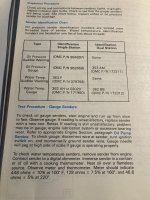millermankjm
Recruit
- Joined
- Sep 9, 2023
- Messages
- 5
New boat, 1988 Four Winns Horizon 180 with OMC 4.3 and Cobra outdrive. Got it started after being down for about 2 years sitting. Appears my choke is not closing all the way so have to encourage with a bit of starter fluid sprayed into carb venturi with choke flap open. Starts and idles at 800 rpm. So far so good. Ran for 10 minutes and monitored all the gauges and saw the water temp gauge rise gradually to 220 or so and then started falling until it went to zero. Thinking that the sensor is not getting any water on it to tell water temp gauge true water temp or gauge is bad. Took boat back in and held off running till tonight and ran for 20 minutes without any issues except gauge still to the left at zero. Felt hoses and they were warm but not untouchable. I have another boat, same vintage Four Winns 200 with another 4.3 I recall which I got for free with a nice trailer as the guy wanted it out of his storage yard by an long gone renter. So my basic question is, without proper working water temp gauge and or temp sender, how can you tell if an engine is overheating? I know a car engine will lose power and overheat through the radiator cooling system but this boat has an open system pumping raw water through the engine block. Just don't want to damage the engine by running if it could be getting too hot and not showing signs of such. Will be swapping out gauge first then sensor that was on the other boat to see if that works. Saw that to test impeller is to remove the raw source water pipe and look for a stream 2 to 4 inches high when held up so I do that test too.
Other question is hearing a erratic clunking at low forward speed every say 3-4 seconds but not with a higher forward speed. Almost like it is popping in and out of gear at low forward speed but not that actually happening.
Final question is my power tilt "shocks" have no stay.. and void of fluid. Assume there is a resivoir to try check level and fill if necessary. Have not got the boat up to plane yet as on a pond with only headway speed limit. Will move to big water to test planing but with no fluid holding the outdrive still, reverse will be very slow. so as the outdrive does not ride up due to no pressure in those "shocks".
Thanks in advance for any help! I'm like a new boater on the day he gets his boat and the day he sells it!
Other question is hearing a erratic clunking at low forward speed every say 3-4 seconds but not with a higher forward speed. Almost like it is popping in and out of gear at low forward speed but not that actually happening.
Final question is my power tilt "shocks" have no stay.. and void of fluid. Assume there is a resivoir to try check level and fill if necessary. Have not got the boat up to plane yet as on a pond with only headway speed limit. Will move to big water to test planing but with no fluid holding the outdrive still, reverse will be very slow. so as the outdrive does not ride up due to no pressure in those "shocks".
Thanks in advance for any help! I'm like a new boater on the day he gets his boat and the day he sells it!




















